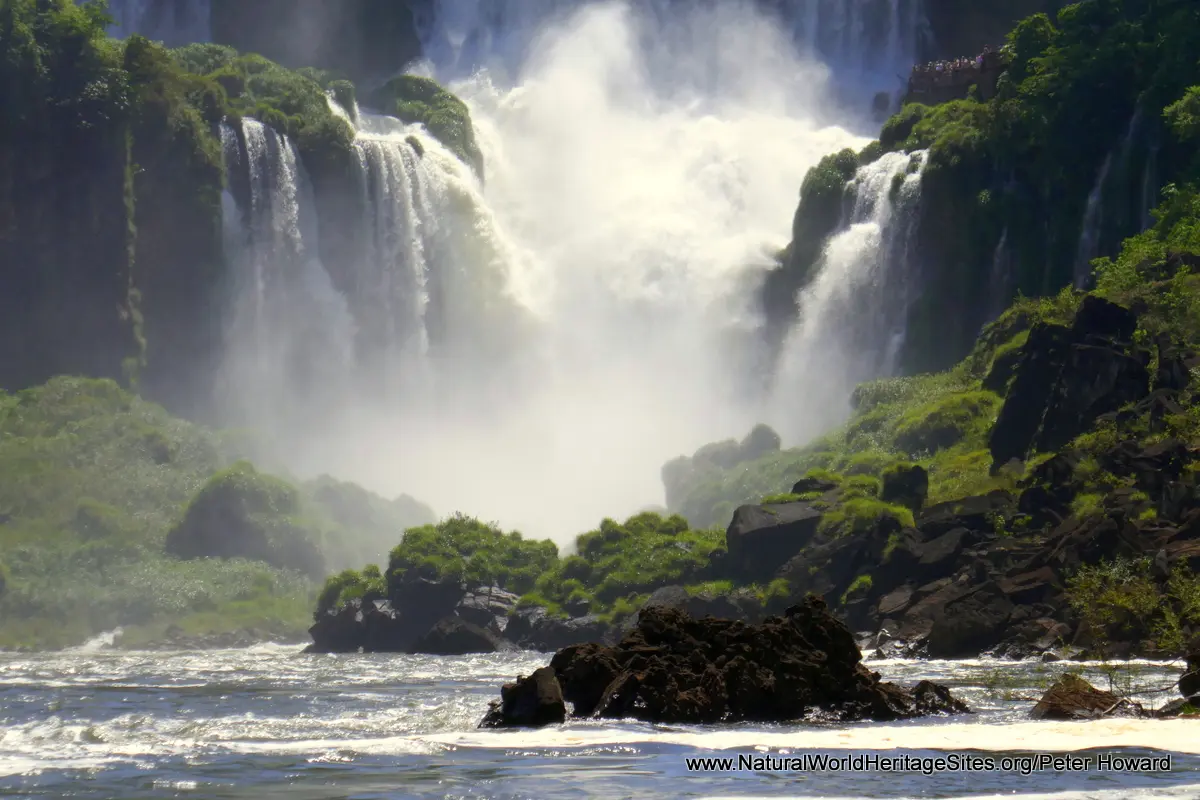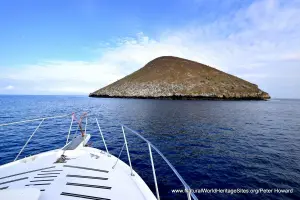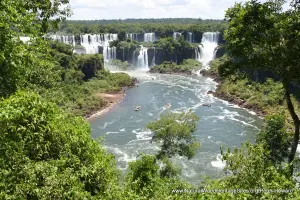EXPLORE Iguacu National Park with this slideshow, check the location map and get all the facts and information below.
For slideshow description see right or scroll down (mobile). Click to view slideshow
Location and Values: Iguacu National Park is located in southern Brazil, close to the border with Argentina and Paraguay. It includes what is, perhaps, the most spectacular complex of waterfalls in the world – a 3km stretch of thundering cascades and rapids set in a lush subtropical forest. The waterfall complex is shared with Argentina and an extensive area of the surrounding forest on each side of the border is protected within adjoining national parks (each of which is also inscribed separately on the world heritage list). This forest is one of the largest remaining remnants of the interior Atlantic Forest, a unique forest type rich in endemic species.
Conservation Status and Prospects. According to IUCN’s Conservation Outlook Assessment (2017) the conservation status of Iguacu National Park is of ‘significant concern’. The IUCN report notes that ‘threats include degradation of the natural setting of the waterfalls, hunting, biological isolation, the effects of unnatural changes in river levels because of upstream dams, including ongoing dam construction in close proximity to the site’s boundaries, and potential ecosystem changes driven by climate change. In general, protection and management of the Park is relatively effective within its boundaries, especially considering the high rate of visitation. While management might improve the natural setting of the falls and reduce hunting, relatively little can currently be done to reduce or mitigate threats originating outside the Park, including biological isolation, the effects of existing dams, water-borne pollutants from agriculture or climate change. ’
Links:
Google Earth
UNESCO Official Website
IUCN Conservation Outlook
UNEP-WCMC Site Description
Birdlife IBA
Slideshow description
The slideshow ‘tells the story’ of Iguacu National Park, showing the spectacular cascades and the variety of forest habitats, plants and animals. The photos were taken by Peter Howard during a visit in January 2019, starting with a short helicopter ride over the falls and surrounding forests. This provides ‘context’ for closer views of the various cascades and features seen at ground level. A striking feature of the overflight is the realization of just how much the land beyond the park boundaries has been cleared for agriculture, leaving the park an isolated remnant of the once-extensive interior Atlantic Forest. Back on the ground, access to the park is provided by a public bus running from the park entrance to a trailhead opposite the lower falls. From here it’s a casual walk along the clifftop trail for about 1 km to the main falls, with a spectacular diversion via an elevated walkway over the water and through the spray onto a lookout in mid-river, below the first main tier of the falls. There is a lookout tower next to the main upper-level cascade with intimate views of the wall of white water at every level.
Whilst the falls themselves are the main attraction at the site, its outstanding importance for biodiversity is also recognized and visitors have an opportunity to experience the wealth of plant and animal species along a number of guided trails through the forest. The slideshow features two of these trails, managed under a concession arrangement by Macuco Ecoaventura. The Trilha Poco Preto takes visitors on foot, bicycle or jeep through a core part of the forest to the river bank, continuing by boat over the placid waters of the river above the falls to a second boat jetty, and from there back through another section of forest to the park’s main access road. This traverse of the forest provides some opportunity to experience the lush Atlantic Forest vegetation and some of the birds and other characteristic wildlife.
The second excursion involves a traverse through the forest to another boat jetty in the fast-flowing waters in the gorge below the falls, and an exhilarating ride in a high-powered rubber dinghy through the white waters to the very base of the falls. Two options are offered – ‘wet’ and ‘dry’; thrill-seekers take the ‘wet’ experience which gets the boat right into the main cloud of spray under the falls!
Factfile
Top 10: One of the ‘Top 10’ sites
Website Categories: Tropical & Sub-tropical Forests; Earth Features
Area: 1,697 km2
Inscribed: 1986
Criteria:
- Outstanding natural beauty (vii);
- Natural habitat for biodiversity (x);
- Significant number of rare, endemic and/or endangered species (x)





